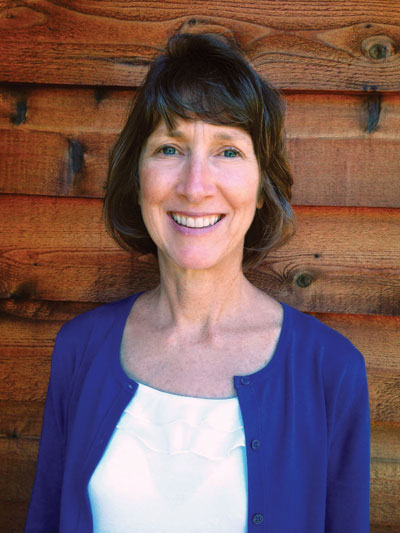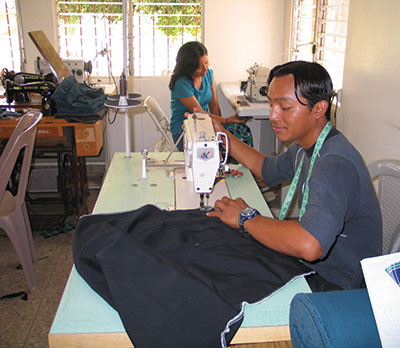
 TV DIRECTOR: Patti Guthrie, director of Better Life TV, says, “The health message can be summarized in a word, and that is Jesus.” " style="font-size: 15px; font-weight: 400; float: right;" class="img-right">
TV DIRECTOR: Patti Guthrie, director of Better Life TV, says, “The health message can be summarized in a word, and that is Jesus.” " style="font-size: 15px; font-weight: 400; float: right;" class="img-right">
When God opened the door for Better Life TV to acquire two major television stations in San Francisco and Los Angeles, Better Life station managers Ron and Marta Davis asked God, “How can we best reach the millions of viewers in these cities?”
They believe that God answered that prayer through networking opportunities at the 2013 ASI National Convention in Orlando.
“In our discussions at ASI it became clear to us that God’s appointed means of reaching people in the cities is through the health message,” Ron Davis said. “With the new stations each offering a capacity for carrying multiple channels, we believed this was a God-given opportunity to start a channel devoted entirely to health.”
In fall 2013 the Better Life TV board voted to approve the development of the round-the-clock health channel called Better Health TV, featuring the best Seventh-day Adventist health programming available. The new channel was to launch in southern Oregon and northern California August 1.
“My sense was that our gospel-based 3ABN programming might not garner the wide appeal we desire in the cities,” Ron Davis said.
“Jesus went from village to village healing the people and teaching them about the kingdom of heaven,” he said. “As Jesus traveled He not only taught people the truth about God—He ministered to their physical needs. Sickness and disease were banished from entire villages as Jesus reached out and touched the lost and dying.”
Davis’ vision is echoed by Patti Guthrie, director of Better Health TV.
“The health message can be summarized in a word, and that is Jesus,” Guthrie said. “Many in our world today don’t sense their need of Christ, but most desire better health. By addressing their physical needs, we believe many people will experience a spiritual awakening and will come to know the Lifegiver through Better Health TV.”
 BIG SMILE: Sathi has reason to be happy after her 4-year-old brother was found." class="img-right" style="float: right;">
BIG SMILE: Sathi has reason to be happy after her 4-year-old brother was found." class="img-right" style="float: right;">
Sathi, a girl of about 9, came bounding into Heather Boyde’s kitchen at the Springs of Life School.
With a sweet smile she said, “Miss, you want to hear some news?”
“Why, yes,” said Boyde, not expecting what came next.
“My little brother is lost,” Sathi said.
Boyde, a teacher and girls’ dean at the boarding school in Kolkata, India, listened in shock. Sathi’s 4-year-old brother had been last seen playing outside a relative’s home. When their father, an alcoholic, had come to pick up the boy, the relative had explained that the boy had disappeared and that she couldn’t find him.
Child kidnapping is very common in this part of India, and the father must have felt deep despair, Boyde said. The father refused to spend time with Sathi until the little boy was found.
The children didn’t have a mother. The woman died when a strong wind rushed into their home, blowing her sari into the fire.
Boyde didn’t know what to say to Sathi. The two knelt down and prayed for the safety of the boy. Then Boyde put her arms around the girl and reminded her of the biblical story of Joseph. “Joseph’s mother died, and he was taken away from his home just like you,” she said. “But God turned it all for good, and because of him the lives of his brothers and father were saved.”
Sathi thought a moment and said, “And he forgave his brothers.”
After a long silence, Boyde asked, “Do you have anyone you need to forgive?”
Sathi nodded. “My whole family,” she said.
The two discussed forgiveness and God’s example in forgiving people. Sathi said she longed to share God with her father.
Then she got up from Boyde’s lap and announced, “Now I can go to sleep.”
Not long after the nighttime conversation, Sathi’s brother was found living in a home down the street from where he had disappeared. It turned out that a neighbor had mistaken him for a street child and adopted him.
 TAILORING SCHOOL: Orphans learning a trade at the International Children’s Care village in El Salvador. " class="img-right" style="float: right;">
TAILORING SCHOOL: Orphans learning a trade at the International Children’s Care village in El Salvador. " class="img-right" style="float: right;">
The ground began to shake at 11:35 on a Saturday morning. The event wasn’t unusual for the people of El Salvador, except this time the shaking seemed to last forever.
After about 45 seconds of violent shaking, the mountain split at the rim, creating a catastrophic landslide that buried the small village at its foot. Entire families lost their lives in an instant, including the parents of little Ernesto.
The small boy wandered through the rubble looking for anybody he knew, but he found no one. Eventually Ernesto was taken to a center for lost children in hope that someone would come looking for him. Nobody did.
After a stint in a government institution, Ernesto arrived at a children’s village operated by International Children’s Care.
Ernesto was a quiet boy who didn’t get into much trouble. But it was obvious that he lived in pain. He would sit outside his house and stare into the distance as if waiting for a long-lost friend.
He slowly began to open up and, as he grew older, expressed a longing for a family. He asked the village social worker to help find a relative. “There must be somebody out there related to me,” he said.
After much work the social worker learned there were no survivors of the village and only one former villager remained alive, an old man who had left before the quake.
The children’s village contacted the old man. By then Ernesto was 19 and a trained tailor. He didn’t remember the old man, but that didn’t matter. To him, the man was a connection to his past. They met and established a warm friendship.
One day the old man said to Ernesto, “I don’t have any family of my own, and my house is too big for just me. I want you to know that if you ever need a home, there is room for you in mine.”
Ernesto couldn’t believe it. He had not found his family, but he had found someone who loved him. He now operates a tailor shop in the old man’s house—in his new home.
 RECOVERY COURSES: Cheri Peters, founder of True Step Ministries, has created a recovery program based on Ellen White’s Steps to Christ. " class="img-right" style="float: right;">
RECOVERY COURSES: Cheri Peters, founder of True Step Ministries, has created a recovery program based on Ellen White’s Steps to Christ. " class="img-right" style="float: right;">
Cheri Peters spent the first 20 years of her life fighting addictions and dysfunction.
Alcoholism, drugs, and relational and sexual addictions ran rampant throughout her extended family. She left home at 13 and spent 10 years on the streets of Los Angeles.
Peters said she couldn’t believe how blessed she felt when she met God and, through an Adventist family, was introduced to the Adventist Church.
She soon found, however, that her struggles were far from over.
Peters immediately started to take Bible studies. But after being raised in a home filled with pain and addictions, she had too much baggage, too much emotional pain, to benefit fully from the studies. She said it took years of healing before she began to surrender the shame of her past and fully realize she was a member of God’s family.
Through her experience Peters began to feel a need to help other wounded Adventists talk freely about their struggles—not in a way that focused on the past, but in a way that allowed the issues to be surrendered to God while being guided in establishing a strong Christian foundation.
“I believe God gave me this passion. I laughed out loud when He started impressing me to write something for the churches—for all the Adventist churches worldwide,” Peters said. “To equip 20 million members to find healing themselves and offer healing to their communities? At first it seemed ridiculous that I should even think about doing something like that.”
In 2013 Peter’s True Step Ministries released its first 14-week recovery program called Celebrating Life in Recovery. A 12-step program, it is based on Ellen White’s
Steps to Christ, with changes in the text to reflect the language of recovery, and includes real-life stories from the Celebrating Life in Recovery television program on 3ABN. The target audience is anyone who struggles with emotional pain, dysfunction, compulsive behavior, or addiction.
 SMOOTHIE TIME: A junior chef getting ready to make a rainbow smoothie as part of Modern Manna’s healthy lifestyle program. " class="img-right" style="float: right;">
SMOOTHIE TIME: A junior chef getting ready to make a rainbow smoothie as part of Modern Manna’s healthy lifestyle program. " class="img-right" style="float: right;">
The children excitedly smiled when they were asked, “How many of you ate one color today?” Nearly every hand shot up.
To the next question every hand except one went down: “How many of you ate two colors today other than brown?”
The results of the informal poll of a small Sabbath school class reflect a trend in the U.S. and other countries. Some children don’t eat breakfast, and many who do prefer processed foods and foods devoid of health-promoting phytonutrients and fiber.
Mothers at the Southgate Seventh-day Adventist Church, in an economically disadvantaged area of south Sacramento, California, are determined to change that.
On Sabbath mornings children who arrive early to church can don the hat of junior chef and assist in creating—and drinking—rainbow smoothies.
As fruits and vegetables in the colors of the rainbow are tossed into a blender, smiles erupt, and children call out the name of the fruit and its color. They learn the value of eating a variety of life-giving colors and that God has given the foods as nature’s medicine. As part of the morning activity, children ages 7 to 12 also learn about the principles of food and health and are encouraged to create healthy lifestyle habits for themselves.
Parents, meanwhile, can participate in healthy cooking classes and natural healing workshops at the church.
To promote these projects in Adventist churches, Modern Manna, a self-supporting ministry focused on effective health evangelism, launched MORE, or Moms Organized for Raw Eating. The movement organizes mothers to become actively engaged in teaching children the importance of eating MORE rainbows. It builds on the foundation of the “eight laws of health” presented through another acronym RAINBOWS, or rest, activity, in control, nutrition, believe, oxygen, water, and sunshine.
Sabon Gida is a farm settlement in southeastern Nigeria, not far from the area where Muslim militants are trying to set up a strict Islamic state through violence and other means, including the kidnapping of more than 200 schoolgirls in April.
The remote area’s first Adventist is Andarawus Adamu, who heard about the seventh-day Sabbath while listening to Adventist World Radio in his native Hausa language.
After hearing the radio broadcasts, Adamu unsuccessfully tried to find an Adventist church and had nearly given up when a newly baptized Adventist, Rose Nelson, happened to visit his area in late 2012. Nelson gave Adamu and several other people Bible studies, and Adamu decided that he wanted to observe the Sabbath.
At Adamu’s request, the nearest Adventist pastor, Dave Onuwah, began to visit and hold Bible studies with him the following January. Four months later, in April 2013, Adamu was baptized.
But then the pastoral visits stopped. The pastor was unable to reach Adamu’s settlement for the next eight months because the start of the rainy season made it impossible to navigate the difficult terrain.
Imagine the pastor’s surprise when he showed up at Adamu’s home in January 2014 and found that Adamu had been actively sharing his new faith with family and friends. After a one-week Bible study the pastor baptized seven people, including Adamu’s parents, on January 25.
 NEW LIFE: Jessica Nyberg, the LifeStyle TV viewer whom Claus Nybo met in Finland, getting baptized on June 28, 2014, by Jonathan Karlsson, a Bible worker at Vegana Center of Influence. After her baptism she wrote Nybo: “I found LifeStyleTV five months ago, and it has helped me so much in my search for truth. It is part of my life every day, and I am so happy for what I have learned. Thank you!”" class="img-right" style="float: right;">
NEW LIFE: Jessica Nyberg, the LifeStyle TV viewer whom Claus Nybo met in Finland, getting baptized on June 28, 2014, by Jonathan Karlsson, a Bible worker at Vegana Center of Influence. After her baptism she wrote Nybo: “I found LifeStyleTV five months ago, and it has helped me so much in my search for truth. It is part of my life every day, and I am so happy for what I have learned. Thank you!”" class="img-right" style="float: right;">
Claus Nybo began to dream while working as a 3ABN producer a decade ago.
The series of programs that he produced,
UpClose, were all taped on location in various Adventist churches. As he traveled from place to place, people repeatedly shared stories of how they had joined the Adventist Church after watching 3ABN.
Nybo began to wonder whether he would see the same results if he started a television channel in Scandinavia.
It was “a bizarre dream when you consider how secular Scandinavia is, with less than 2 percent of the population attending any church,” Nybo said.
Complicating matters, the Adventist Church has seen negative growth for years in the countries of Finland, Sweden, Norway, Denmark, and Iceland, and today can count only about 4,000 attendees out of a population of 20 million on any given Sabbath, he said.
“Yet does not an uplifted Savior have power to draw men to Himself today, even in forbidding places like this?” Nybo said. “God’s dreams and visions may seem bizarre to us, but to a God in the miracle-working business, they are commonplace.”
So LifeStyleTV was born eight years ago.
Nybo said he has witnessed many miracles during the daily operations of LifeStyleTV. But perhaps the biggest miracle, he said, is that viewers are walking into Adventist churches seeking baptism—just as in the U.S.
After he’d spoken at a recent conference, a woman approached Nybo with a big smile and warm hug.
“With sparkling eyes she told me how watching
Stridens Hopp—our Great Controversy TV series—had impacted her life and that she was now going to be baptized,” Nybo said. “She is now studying with local Bible workers to prepare for baptism.”
LifeStyleTV exists for miracles like this: to see viewers’ lives change as they connect with Jesus, he said.
 IPHONE CHECK-UP: A medical volunteer with Broken Chains for Human-ity checking a girl in Guatemala." class="img-right" style="float: right;">
IPHONE CHECK-UP: A medical volunteer with Broken Chains for Human-ity checking a girl in Guatemala." class="img-right" style="float: right;">
Guatemala is a land of incredible beauty, but it is also a land of a downtrodden, broken people. It continues to roil from earthquakes, volcanoes, droughts, floods, death by malnutrition, and a 30-year civil war that killed 200,000 people.
Guatemala also is a land ripe for harvest.
In 2005 Thania Castanaza, a member of the Antioch Seventh-day Adventist Church in California, asked her pastor if the church could go on a mission trip.
“Where should we go?” Pastor Ron Cook asked.
“I want to go back to Guatemala, where I was born and raised,” she said.
Castanaza, who had grown up in Guatemala City, explained that she had called some long-lost relatives in the Guatemalan mountains to see if they could use some missionaries. To her amazement, the relatives said they had just built six new rooms onto their house, praying that missionaries would come one day to stay in them.
The first mission trip took place in 2006 when members from the Antioch church traveled to Jalapa, Guatemala. Members from other Adventist churches joined Antioch on subsequent trips, and the work kept expanding. Finally in 2010, Broken Chains for Humanity, a U.S. nonprofit group, was established to accommodate the churches joining Antioch on the mission trips.
In March 2014, 37 people from seven churches joined Broken Chains for Humanity on its seventh mission trip to Jalapa, Guatemala.
During the 11-day stay the missionaries cared for 800 patients at free medical and dental clinics. Los Angeles-based Dr. Danny Castanaza led out in organizing the clinics with his brother Job, who lives in Jalapa. The missionaries prayed with every patient who received treatment.